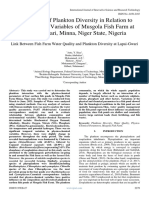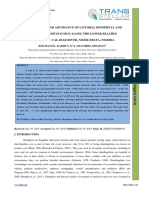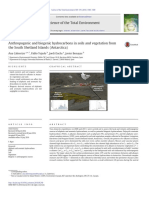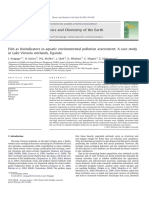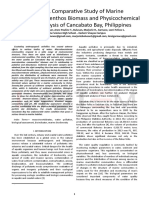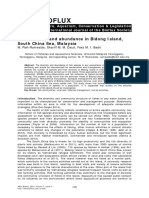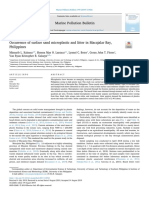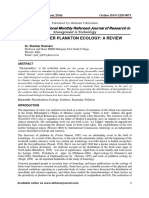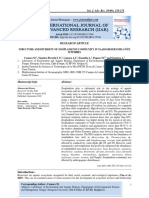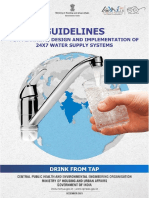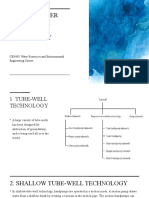Professional Documents
Culture Documents
Baseline Study of The Physico-Chemical Parameters and Plankton Productivity of Ibeno Atlantic Coastline, South Nigeria
Original Title
Copyright
Available Formats
Share this document
Did you find this document useful?
Is this content inappropriate?
Report this DocumentCopyright:
Available Formats
Baseline Study of The Physico-Chemical Parameters and Plankton Productivity of Ibeno Atlantic Coastline, South Nigeria
Copyright:
Available Formats
Volume 6, Issue 6, June – 2021 International Journal of Innovative Science and Research Technology
ISSN No:-2456-2165
Baseline Study of the Physico-Chemical Parameters and
Plankton Productivity of Ibeno Atlantic Coastline, South Nigeria
Paul Onu Ajah, Love Nneka Allison, and Peter Ene Asuquo.
Faculty of Oceanography,
University of Calabar, Nigeria.
Abstract:- Baseline study of the plankton productivity of demand and life activities. Besides the fact that fish requires
Ibeno Atlantic coastline, South south Nigeria was carried good water to thrive in (Bhatnagar & Devi, 2013), it should
out every second week of the month for 13H/day be noted that fish equally contribute a lot to the poor quality
beginning from 0600 to 1800 hours at both surface and of their immediate environment through the release of
interstitial waters from November 1996 to June 1998. metabolic wastes. Water quality which is the totality of
Physicho-chemical parameters and major elements were chemical, physical and biological contents of the water has
analyzed. Moderate acidity during the dry season and to be optimum for fish survival and growth. Man and
alkaline medium during the wet season were observed. nature’s contributions via nutrition determine the quality of
Wet season turbidity, D.O., colour, NO3, PO4, Silicate water. Water qualities may also be affected by low water
decreased sharply from those of the dry season while pH flow, municipal effluents and industrial discharges
and NH4 did not vary significantly between seasons. (Chitmanat & Traichaiyaporn, 2010) as well as the fish’s
Peak phytoplankton production of five classes, 35 genera metabolic wastes. Some physical and chemical parameters
and 42 species occurred in October 1997 with such as pH, temperature, dissolved oxygen, total suspended
Bacillariophyceae dominance while peak zooplankton solids, total dissolved solids, total alkalinity, acidity,
species (28) belonging to 21 genera, 19 of which was from salinity, conductivity, nutrients and heavy metals
the class Copepoda were observed. High plankton contamination in one way or the other limit the survival of
densities were identified between 0600 and 0800 and aquatic flora and fauna (Soni & Thomas, 2013). All aquatic
1300 to 1600 hours. At interstitial water depths of 0cm, lives including plankton have tolerable limits of water
10cm, 20cm and 30cm, plankton densities decreased with quality parameters in which they perform optimally. A sharp
depth. Plankton productivity took a sinusoidal curve and drop or an increase within these limits has adverse effects on
was not unconnected with the tidal changes. their body functions (Davenport, 1993; Kiran, 2010; Ajah,
Chlorophyll-a values ranged from 0.00002 to 0.0008 2010) and existence (Ekpo, 2013). Some contaminants can
mg/l. Grazing by zooplankton was evident. accumulate to the point where it threatens human health
even in low quantities and cause no obvious adverse effects
Keywords:- Physico-Chemical, Plankton, Productivity, (Philminaq, 2014). Aquaculture, fish-trawling, chemical
Grazing, Interstitial. pollution, and sewage discharges are the most common
sources of human impacts that affect biodiversity and the
I. INTRODUCTION goods and services it provides at regional scales (EEA
2006). So far, there has been no documented planktonic
Coastlines, the world over are characterized by high research in the Ibeno Coastal Waters. Researches carried out
productivity, fishing, transportation, sports and associated so far centered on metals in tar balls (Asuquo, 1991;
maritime activities (Ehlin, 1995; Mackey, et al., 2010) as Asuquo, Ukpabio & Ehrhardt, 1996) and surface water
well as high human population densities resulting in chemistry Qua Iboe River, Ibeno Coastal waters (Asuquo,
uncontrollable dumping and discharge of domestic, 1997). Knowing the state of the environment, structure and
municipal and industrial wastes. Economically, the coastal function of the communities in the ecosystem is of essence
zone of Nigeria, a stretch of over 800 km from Bakassi in while drawing up management plans which will in turn
the South South to Badagry in the west contributes to the reduce negative effects of unsustainable development and
domestic fish supply and about 23, 486,000 tons of oil per eventual pollution. Due to the fragile nature of planktonic
annum (World Resources, 1990). Ibeno coastline where the organisms, this premiere study in Ibeno South Atlantic
study was carried out covers a distance of about 10 km of waters seeks to investigate the water quality by analyzing
the Atlantic coastline. Water is the physical habitat wherein the physicochemical parameters and hence the plankton
fish dwell and carry out their life metabolic processes such biodiversity and productivity at seasonal and tidal levels to
as swimming, breeding, feeding, digestion, excretion and serve as baseline data bank to assist in future management
relaxation (Bronmark & Hansson, 2005). These metabolic policies.
processes are affected primarily by temperature, oxygen
IJISRT21JUN656 www.ijisrt.com 1317
Volume 6, Issue 6, June – 2021 International Journal of Innovative Science and Research Technology
ISSN No:-2456-2165
Figure 1. Map of Akwa Ibom State showing the location of the study area (Ibeno Atlantic coastline)
II. MATERIALS AND METHODS The following physicochemical parameters (pH,
temperature, Dissolved Oxygen-D.O, conductivity, total
The Ibeno Atlantic coastline lies between latitude dissolved solute- TDS, total alkaline, Total Hydrocarbon-
4o32” and 4o36” N and longitude 8o00” and 8o16” E THC, Hardness, Colour, Salinity), and nutrients- (P-PO4--,
covering 10 km out of the 800 km of the Nigerian coastline N-NO3-, N-NO2, N-NH4+/NH3, SO4--, Biochemical Oxygen
that begins from Bakassi to Badagry in the west. Ibeno Demand- BOD5, Chemical Oxygen Demand- COD, Silicon
beach has a flat foreshore known for its low gradient nature Si,), and two major elements –(Calcium- Ca, and
with fine grain sand and a lot of beach ridges. Magnesium- Mg) were monitored. pH meter was used to
measure the pH, Ice chest was used to transport samples for
The research which covered a period of 21 months chlorophyll-a analysis by spectrophotometric determination
started in November 1996 and terminated in June 1998. after sedimentation (Parson, et al, 1984). Primary
Both the surface and interstitial coastline waters at 0 cm, 10 production using the chlorophyll a method (UNESCO
cm, 20 cm and 30 cm depths were monitored during the (1966) and the direct count method for qualitative and
second week of every month at hourly intervals (13 hours quantitative determinations were carried out.
per sampling day) at designated station determined by the
use of GPS model for plankton and physico-chemical The species identified were further analyzed to
parameters. Sampling was done in four phases- early dry determine their abundance, density, percentage composition
season October, November and December, late dry season- and species richness using Gleason’s index (Margelef 1968).
January, February and March, early rainy season- April,
May and June and late rainy season-July, August, and
September.
IJISRT21JUN656 www.ijisrt.com 1318
Volume 6, Issue 6, June – 2021 International Journal of Innovative Science and Research Technology
ISSN No:-2456-2165
Gleason’s index (D’) = S-1/In N Phosphate was the limiting nutrient at both surface and
Where: S = the total number of taxa, and N = the total interstitial waters. Silicate ranged from a minimum of 0.3
number of individuals. mg/l on surface water in May to 0.499 mg/l in January 1997.
The least value of 0.505 mg/l in interstitial water was in
III. STATISTICS January 1997 while the highest value (0.86 mg/l) was
recorded in August 1997. All time high total hydrocarbon of
The mean values of physicochemical and plankton 25.56 mg/l was observed in November (Figures 3 & 4).
communities were subjected to Analysis of variance Moderate acidity during the dry season and alkaline medium
(ANOVA) to determine their level of significance at during the wet season were observed which agrees with
probability level p=05. Dunbar (1979). Wet season turbidity, D.O, colour, NO3,
PO4, Silicate decreased sharply from those of the dry season
IV. RESULTS AND DISCUSSIONS while pH and NH4 did not differ much between seasons.
Ram (2000) while working on tropical inter tidal sediment
The physicochemical parameters of Ibeno South observed increase of PO43-P, NH4+-N, pH, Cl and Total
Atlantic surface water between the dry season and wet alkalinity with increase in depth whereas NO3--N did not
season are represented in Figure 1. No statistically decrease with depth. Murray, Grundmanis and Smethie
significant difference (p>0,05) was observed amongst the (1978) also noticed increase of ammonia and alkalinity with
physico-chemical parameters. The pH, temperature, D.O, increase in depth while sulfate and organic carbon decreased
Turbidity, colour, and BOD5 of surface water were always with depth.
higher than interstitial (Figur5) waters while total alkalinity,
chloride, salinity, nitrate, silicate and total hardness of Results of phytoplankton (Figure 7) and zooplankton
interstitial waters were always higher than those of surface (Figure 8) communities of Ibeno South Atlantic Ocean
waters as shown in Figure 6. Conductivity was higher in showed heteroscandicities giving rise to October peak at
interstitial waters than surface waters in the dry season. The 09.00H followed by 18.00H and thirdly 16.00H for
reverse was the case during the wet season. Ekelemu and zooplankton and phytoplankton peak at 09.00H followed by
Zelibe (2006) while working on Lake Ona in Asaba, 18.00H and thirdly at 10.00H. Hourly variations in
Nigeria, observed significant inter-seasonal variations productivity were not unconnected with the tidal changes.
(P<0.05) changes only with water temperature, water level, Overall, 22 phytoplankton species from 19 genera basically
total alkalinity, calcium ion, dissolved oxygen, conductivity, of Bacillariophyceae and 28 zooplankton species of 21
phosphate as well as transparency, other water parameters genera with the highest abundance from class Copepoda
did not correlate significantly with season (P>0.05). The were observed. Table 1 gives a run view of the species of
present research observed clear seasonal differences in most plankton community present in the study area. Chlorophyll a
of the parameters. pH for surface water and interstitial value ranged from 0.002 to 0.0008 mg/l. In general, high
waters ranged from 6.68(5.65) to 6.7(6.53) during the dry plankton densities were recorded at 0800, 1300, 1400 and
season and 7.2(7.35) to 8.35(8.2) during wet season. High 1500 hours. Plankton community in the interstitial waters
temperature ranges from 29.1 to 29.8 and 28.4 to 29.3 oC, decreased with depth. Plankton productivity took a
respectively, for dry season surface and interstitial and 25.3 sinusoidal curve most likely due to the tidal changes in the
to 28.3 oC (surface) and 24.7 to 26.6 oC (Interstitial) during ecosystem. Species richness using Gleason’s index (D’) was
the wet season. Dissolved oxygen (D.O) for dry and wet 6.945 and 3.892 for phytoplankton and zooplankton,
season surface water ranged from 5.3 to 5.9 and 1.55 to 3.9 respectively.
mg/l while in interstitial waters dry season ranged from 3.04
to 3.58 and wet season from 0.98 to 3.92 mg/l. Turbidity Between September and November 1997, the highest
rose as high as 252.6 FTU during the dry season to a low of number of 35 genera and 42 species of phytoplankton were
28.6 FTU during the wet season for surface waters while observed in the month of October. The classes also
interstitial waters was 140 to 24.8 FTU respectively. Salinity increased from three to five. Bacillariophyceae,
was generally diluted from a high of 22.4 and 23.5 ‰ to a Chlorophyceae, Desmonkontae, Euglenophyceae and
low of 7.4 and 6.87 ‰, respectively, for dry and wet vascular plants (Tracheophyta). The class Bacillariophyceae
season’s interstitial waters and surface water. Ammonium was still dominant over others. The zooplankton community
peaks were 4.38 mg/l surface and 5.20 mg/l interstitial in had 19 genera and 19 species with the class Copepoda still
November during the dry season and reduced to 3.93 mg/l the dominant class followed by Oligochaeta then Ostracoda.
surface to 2.70 mg/l interstitial at the early rains in May and The result so far depicts grazing of zooplankton on
finally to 3.22 surface and 2.81 mg/l interstitial in August phytoplankton. The peak periods of plankton abundance
1997. Sulphate ranged from 1173.9 to 1554 mg/l surface were observed between 0600, to 0800 and 1400 to 1600
and 974.7 to 1174 mg/l for interstitial waters during the dry hours. Chlorophyll a values increased slightly from 0.0008
season to all time high 1818 mg/l surface water in May with to 0.001 mg/l. Hourly variations in productivity were still
the lowest values of 536.6 and 572.7 mg/l respectively for not unconnected to the tidal changes. Interstitial waters at 0
surface and interstitial waters in August 1997. Nitrate values cm, 10 cm, 20 cm, and 30 cm depths had fewer planktonic
were higher in the dry season in both surface and interstitial organisms than the coastal waters and decreased in
waters 4.39 to 4.91 mg/l and 5.08 to 5.20 mg/l respectively, abundance with increase in depth. A generally sigmoidal
decreased to 0.19 to 0.44 mg/l from May to August for pattern of plankton abundance was equally observed with
surface and 0.29 to 2.12 mg/l for interstitial water. tidal changes. The differences in high and low tides were
IJISRT21JUN656 www.ijisrt.com 1319
Volume 6, Issue 6, June – 2021 International Journal of Innovative Science and Research Technology
ISSN No:-2456-2165
greatest every two weeks when spring tides occurred and European Environment Agency - EEA Report,
smallest during the alternate weeks when neap tides Copenhagen, Denmark, 4, pp. 88.
occurred. [10]. Ehlin, U. (1995). The Helsinki Commission. Guardian
of and catalyst for the protection of Baltic Sea Marine
The state of environment, structure and functional Environmental Protection Commission,
communities of Ibeno South Atlantic Ocean as elucidated Katahanokanlaituri 6B, FIN-00160 Helsinki, Finland.
will invariably assist in drawing up management plans of [11]. Ekelemu, J.K. & Zelibe, S.A.A.. (2006). Aspects Of
this ecosystem and in turn help to ameliorate any subsequent Hydrobiology Of Lake Ona In Southern Nigeria 2:
negative effects of unsustainable development and eventual Physical And Chemical Hydrology, Journal Of
pollution. Planktonic organisms which are fragile in nature Environmental Hydrology. The Electronic Journal of
have been used for this study to investigate the water quality the International Association for Environmental
by analyzing the physicochemical parameters and hence the Hydrology On the World Wide Web at
plankton biodiversity and productivity at seasonal and tidal http://www.hydroweb.com 14(21): 1-10.
levels thus serving as base data bank to assist in future [12]. Ekpo, I. (2013). Effect of physico-chemical parameters
management policies of the Ocean. on zooplankton species and density of a tropical
Rainforest Rivers in Niger Delta, Nigeria using
ACKNOWLEDGEMENT canonical cluster analysis. The International Journal
of Engineering and Science (IJES, 2(4): 13-21.
The authors are grateful to late Mr. Emmanuel Bassey [13]. Kiran, B.R. (2010). Physico-chemical characteristics
and Prof. F.E. Asuquo who collected and analyzed the of fishponds of Bhadra project at Karnataka. Rasāyan
physicochemical parameters of the coast. Journal of Chemistry, 3 (4): 671-676.
[14]. Mackey, K.R.M., van Dijken, G.L., Mazlooom, S.,
REFERENCES Erhardt, A.M., Ryan, J., Arrigo, K.R. & Paytan, A.
(2010). Influence of atmospheric nutrients on primary
[1]. Asuquo, F.E. (1991). Tar balls on Ibeno-Okposo productivity in a coastal upwelling region. Global
Beach of South-east Nigeria. Marine Pollution Biochemical Cycles, 24: 1-19. GB4027,
Bulletin, 22(3): pp150-151. doi:10.1029/2009GB003737
[2]. Asuquo, F.E., Ukpabio, E.J., & Ehrhardt, M. (1996). [15]. Murray, J.W., Grundmanis, V. & Smethie, W.M.
Composition and sources of Nigerian Beach (1978). Interstitial water chemistry in sediment of
tars.Global Journal of Pure and Applied Sciences, 2: Saanich Inlet. Geochimica et Cosmochimica Acta,
171-182. 41:1011-1026.
[3]. Asuquo, F.E. (1997). Tar balls monitoring: A classical [16]. Philminaq, Annex 2 (2014). Water Quality Criteria
tool for the assessment and evaluation of marine and Standards for Freshwater and Marine Aquaculture
pollution by petroleum. Commonwealth Proceedings <URL:http://www.aquaculture.asia/fies/PMNQ%20
on Environment, 1:20-25. WQ%20standard%202 pdf. Accessed 04 May 2018.
[4]. Bronmark, C. & Hansson, L.A. (2005). The biology of [17]. Ram, A. (2000). Interstitial water chemistry and
lakes and ponds. Oxford University Press, Oxford, nutrients fluxes from tropical intertidal sediment.
UK, pp. 285. Indian Journal of Marine Science, 29: 310-318.
[5]. Bhatnagar, A., & Devi, P. (2013). Water quality [18]. Soni, H.B. & Thomas, S. (2013). Preliminary
guidelines for the management of pond fish culture. assessment of surface water quality of tropical
International Journal of Environmental Sciences pilgrimage wetland of Central Gujarat, India.
3,(6):1980-2009. International Journal of Environment, 2(1): 202-223.
[6]. Chitmanat, C., & Traichaiyaporn, S. (2010). Spatial DOI:10.3126/ije.v2i1.9222.
and temporal variations of physical-chemical water [19]. Sonila, K.F., Qarr, P., & Lazo, L.B. (2015). The effect
quality and some heavy metals in water, sediments and of physico-chemical parameters and nutrients on
fish of the Mae Kuang River, Northern Thailand. fish growth in Narta Lagoon, Albania. Journal of
International Journal of Agriculture and Biology, 12, Hygienic Engineering and Design 62-68.:
(6), pp. 816-820. https://www.researchgate.net/publication/274073951.
[7]. Davenport, Y. (1993). Responses of the Blennius [20]. UNESCO (1966). Determination of photosynthetic
pholis to fluctuating salinities. Marine Ecology pigments in sea water- Report of SCOR-UNESCO
Progress Series, 1: 101-107. Working group 17 (Paris): Monographs on
[8]. Dunbar, R.I.M. (1979). Energetics, thermoregulation, Oceanographic Methodology 1, 69 pp.
and the behavioural ecology of klipspringer. African [21]. World Resources (1990). A guide to the global
Journal of Ecology, 17:217-230. environment. A Report of the World Resources
[9]. EEA (European Environment Agency). (2006). Institute in Collaboration with the UNEP and UNDP,
Priority Issues in the Mediterranean Environment. Oxford University Press, N.Y.
IJISRT21JUN656 www.ijisrt.com 1320
Volume 6, Issue 6, June – 2021 International Journal of Innovative Science and Research Technology
ISSN No:-2456-2165
Dry Season Nov-96 Dry Season Jan-97
Wet Season May-97 Wet Season Aug-97
Wet Season Aug-97,Wet
D.O.Season Wet Season
mg/l, Aug-97, Cond Aug-97, Turb (FTU), Wet Season Aug-97, Chloride x
1.55 ms/cm, 10.66 28.6 Wet Season Aug-97, Colour x 102, 38.2
Wet Season Aug-97, Temp oC, 102, 2.21 Wet Season Aug-97, Tot
Wet Season Aug-97, Tot. Alka,
Wet Season Aug-97, PH, 8.35 25.3 Wet Season May-97, Turb (FTU), Hardness x 102, 4.13
102.7
67.2
Wet Season May-97, D.O. mg/l,
5.4 Wet Season May-97, Cond Wet Season May-97, Chloride x
Dry Season Jan-97, Turb
Wet (FTU),May-97, Colour x
Season
ms/cm, 36.41 30.75 102, 2.96Wet Season May-97, Tot 102, 130.5
Wet Season May-97, Temp oC,
28.3 Hardness x 102,
Wet3.91
Season May-97, Tot. Alka,
Wet Season May-97, PH, 7.2 Dry Season Jan-97, Tot Hardness95
x 102, 0
Dry Season Jan-97, D.O. mg/l, Dry Season Jan-97, Colour x 102,
5.3 3.08
Dry Season Jan-97, Temp oC, Dry Season Jan-97, Cond ms/cm, Dry Season Jan-97, Chloride x
29.28 30.3Dry Season Nov-96, Turb (FTU), Dry Season Jan-97, Tot. Alka,
Dry Season Jan-97, PH, 6.68 102, 111.16
96.26
252.6 Dry Season Nov-96, Tot
Hardness x 102, 10.01
Dry Season Nov-96, D.O. mg/l, Dry Season Nov-96, Colour x
Dry Season Nov-96, Temp oC, 5.9 Dry Season Nov-96, Cond 102, 4.33 Dry Season Nov-96, Tot. Alka,
Dry Season Nov-96, Chloride x
Dry Season Nov-96, PH, 6.7 29.1 ms/cm, 24.4 90.4 102, 83.95
Figure 1. The physicochemical parameters of surface water Ibeno South Atlantic
Ocean during the dry and wet seasons of 1996 and 1997.
Wet Season Aug-97, Salinity,
6.87
Wet Season Aug-97, SO4 x 102,
5.36 Wet Season May-97, Salinity,
23.5
Dry Season Nov-96
Wet Season May-97, SO4 x 102, Dry Season Jan-97
18.18
Wet Season May-97
Dry Season Jan-97, Salinity,
20.08
Wet Season Aug-97
Dry Season Jan-97, SO4 x 102,
15.54
Wet Season Aug-97,
Ammonium, 3.32
Wet Season May-97,
Wet Season
Wet Season May-97,
Aug-97, Nitrate, 0.5
0.2
Dry Season Nov-96, Salinity,
Ammonium, 3.93 Wet Season Aug-97, Tot
Dry Season Nov-96, SO4 x 102, 14.8 Dry Season Jan-97, Nitrate, 4.9
Dry Season Jan-97, Ammonium, WetHydocarbon,
Season May-97,
Wet Tot Aug-97, BOD5, 0.4
1.3Season
11.7 DryHydocarbon, Wet
Season Jan-97, Season May-97, BOD5, 3
4.38 2.18Tot
Dry Season Nov-96,
Dry Season Nov-96, Nitrate, 4.4 Wet Season
Wet Season May-97,
Aug-97, Silicate,
Silicate,
Dry Season Nov-96,
Dry Tot
Season Jan-97, BOD5, 1.25
Wet Season May-97,
Dry Season
Dry Season Aug-97,
Jan-97,
Nov-96, Phospate,
Dry SeasonJan-97,
Phospate,
Phospate, Nov-96, Hydocarbon,
Silicate, 2.03
Ammonium, 2.52 Dry Season 0.45
0.34 Silicate, 0.49 Dry Season
Hydocarbon, 1.76 Nov-96, BOD5, 1.36
0.01
0.2
0.02 0.45
Figure 2. The physicochemical parameters of interstitial water Ibeno South
Atlantic Ocean during the dry and wet seasons of 1996 and 1997.
IJISRT21JUN656 www.ijisrt.com 1321
Volume 6, Issue 6, June – 2021 International Journal of Innovative Science and Research Technology
ISSN No:-2456-2165
Dry Season Nov-96
Wet Season Aug-97, Sal o/oo,
7.4
Dry Season Jan-97
Wet Season May-97, Sal o/oo,
13.4 Wet Season May-97
Wet Season Aug-97, SO4 x
102, 5.72
Wet Season Aug-97
Wet Season May-97,
DrySO4 x Jan-97, Sal o/oo,
Season
102, 10.36 22.4
Dry Season Jan-97, SO4 x 102,
9.74
Wet Season Aug-97, N-NH4
Wet , Aug-97, N-NO3,
Season
2.8 Wet
Wet Season May-97, Season
N-NH4 May-97, N-NO3,
, 2.12
Dry Season Nov-96, Sal o/oo, 2.7 Dry Season0.285
Jan-97, N-NO3, Wet Season Aug-97, Total H.C
Dry Season Nov-96, SO4 x 15.2 Dry Season Jan-97, N-NH4 , 5.08 Wet Season May-97,
, 1.67WetTotal H.CAug-97, BOD5,
Season
102, 11.7 5.2 Dry Season Nov-96, N-NO3, , 1.51Wet
Dry Season Jan-97, Season
Total ,May-97, BOD5,
H.C 0.16
Dry Season Nov-96, N-NH4 , Wet Season Aug-97, SiO3, 2.31 2.53 BOD5, 1.1
Dry Season Nov-96, Total H.C
Dry Season Jan-97,
5.2 Wet
Wet
Dry
Dry Season
Season
Season Wet
Aug-97,
May-97,
Jan-97,
Nov-96, Season
P-PO4,
P-PO4,
P-PO4,
Dry Season May-97,
0.86
Season Nov-96, SiO3,
Jan-97, SiO3, 0.7
3.25 Dry SiO3, 0.51 Dry Season Nov-96, BOD5, 1.4
0.63 , 2.56
0.01
0.02
Figure 4. The nutrients and total hydrocarbon of interstitial water of Ibeno
South Atlantic Ocean during the dry and wet seasons of 1996 and 1997.
IJISRT21JUN656 www.ijisrt.com 1322
Volume 6, Issue 6, June – 2021 International Journal of Innovative Science and Research Technology
ISSN No:-2456-2165
Nov-96 Jan-97 May-97 Aug-97
Jan-97,
Nov-96, Temp.
Temp. oC s.w,
oC s.w, Nov-96, Temp. oC I.W, 29.3
29.129.28
May-97, Temp. oC s.w, Jan-97,
28.3 Temp. oC I.W, 28.4
May-97, Temp. oC I.W, 26.6
Aug-97, Temp. oC s.w, 25.3 Aug-97, Temp. oC I.W, 24.7
Aug-97, pH s.w, 8.35 Aug-97, pH i.w, 8.2
Nov-96, May-97,
pH s.w, 6.7pH6.68
s.w, 7.2 May-97, pH i.w, 7.35
Jan-97, pH s.w, Nov-96, pH i.w, 6.5
Jan-97, pH i.w, 5.65 Nov-96, D.O s.w,
D.O 5.9
May-97,
Jan-97, D.O 5.3
s.w, s.w, 5.41
Aug-97, D.O s.w,
Nov-96,
1.55 May-97,
Jan-97,
D.O i.w,
Aug-97,D.O
D.O3.04
i.w, i.w,i.w,
D.O
3.58 3.92
0.98
Figure 5. Comparative plot of pH, Temp and D.O (±S.D) at both surface and
interstitial waters of Ibeno South Atlantic ocean.
Nov-96 Jan-97 May-97 Aug-97
May-97, SO4 s.w, 18.18
Jan-97, SO4 s.w, 15.54
Nov-96, SO4 s.w, Nov-96,
11.73 SO4 I.W, 11.74
May-97,
Jan-97, SO4SO4
I.W,I.W, 10.36
9.74
Aug-97, SO4 s.w, Aug-97,
5.36 SO4 I.W, 5.72 Jan-97, N-NH4 I.W, 5.2 Jan-97, N-NO3Nov-96,
Jan-97, N-NO3 I.W, 5.1
S.W, 4.9 5.2
Jan-97, N-NH4
May-97, S.W,S.W,
N-NH4 4.383.93
May-97, BOD5 s.w, 3 Aug-97, N-NH4
Nov-96, S.W,
N-NH43.32
I.W,
Aug-97, 3.25
N-NH4 I.W, 2.81 Nov-96, N-NO3 S.W, 3.4
Nov-96,
Jan-97,BOD5
Aug-97,
BOD5s.w,
s.w,
Nov-96,
BOD5
1.36 May-97,
Jan-97,
1.26
s.w,
BOD5
Aug-97,
0.4
BOD5 BOD5
i.w, 1.4i.w,
BOD5
i.w, 1.1 2.50.16
i.w, Nov-96,
Jan-97,
May-97,
P-PO4
Aug-97,
P-PO4
s.w,
P-PO4
Nov-96,
P-PO4
s.w,
0.011
Jan-97,
s.w,
0.024
May-97,
s.w,
P-PO4
0.19
Aug-97,
P-PO4
0.005 Nov-96,
I.W,
P-PO4
I.W,
P-PO4
0.011
I.W,
0.023
I.W, 0.01S.W, 2.52May-97,
N-NH4
0.01 N-NH4 I.W,
Nov-96, 2.7
Jan-97,
May-97,
SiO3
Aug-97,
SiO3
S.W,
SiO3
S.W,
Nov-96,
SiO3
0.45
S.W,
Jan-97,
0.5
S.W,
May-97,
0.34
SiO3
Aug-97,
0.45
SiO3
I.W,
SiO3
I.W,
SiO3
0.63
I.W,
0.51
May-97,
I.W,
0.7
Aug-97,
0.86May-97,
N-NO3
Aug-97,
N-NO3S.W,
N-NO3
S.W,
0.19
0.45
I.W, 0.29
2.12
Figure 6. Comparison of nutrient contents (± S.D) between surface and interstitial waters of Ibeno
South Atlantic Ocean.
IJISRT21JUN656 www.ijisrt.com 1323
Volume 6, Issue 6, June – 2021 International Journal of Innovative Science and Research Technology
ISSN No:-2456-2165
Bacillariophyceae, 9.00H, 1047
Bacillariophyceae
Chlorophyceae
Dinoflagellata
Bacillariophyceae, 18.00H, 451
Bacillariophyceae, 10.00H, 334
Bacillariophyceae, 15.00H, 249
Bacillariophyceae, 16.00H, 211
Bacillariophyceae, 17.00H, 159
Bacillariophyceae, 11.00H, 62
Bacillariophyceae, 13.00H, 31
Fig 7. Showing the Phytoplankton commnity within the sampling period
25
22
20
15 Amphipoda
15
Ostracoda
Copepoda
10 10 Acari
10
Tricoptera
8
77 7 rotifera
6
5 5 Tintinids
5 4
3 Appendiclaria
2 2
1 1 111 1
0
9.00H 10.00Hthe 11.00H
Fig. 8. Shows 13.00H
zooplankton 15.00H
commnity 16.00H
of Ibeno 17.00Hcoast
South Atlantic 18.00H
during the
sampling period.
IJISRT21JUN656 www.ijisrt.com 1324
Volume 6, Issue 6, June – 2021 International Journal of Innovative Science and Research Technology
ISSN No:-2456-2165
Table 1. Shows representative species abundance from the study site within the sampling periods.
Bacillariophyceae Zooplankton
Coscinodiscus Asterionella formosa 1 Denticum Tropocyclops Ergasiloides sp
excentricus 840 brightwellii 4 prasimus 7 1
Melosira 24 Thalassionema nitzschioides Sphaeroplea 2 Synchaeta
1 pectinata 1
Pinnularia nobilis 11 Coscinodiscus radiatus 33 Synura 8 Copepoda 4 Mesocyclops
Bodanicola 1
Biddulphia sinensis 26 Biddulphia mobilensis 10 Goniochloris Gammarus sp 3 Harpaticus
sculpta 3 chelifer 2
Halosphaera. viridis 20 E. americanus 1 Calanus Eucalamus
finmarchinus 20 elongatus 2
Biddulphia. aurita 5 Appendicularia: Cyclops magnus
Fritillaria 1
pellucida 2
Eudiaptomus Balanus
gracilis 3 balanoides 1
Microcyclops 1
IJISRT21JUN656 www.ijisrt.com 1325
You might also like
- Advances in Water Pollution Research: Proceedings of the Second International Conference Held in Tokyo, August 1964From EverandAdvances in Water Pollution Research: Proceedings of the Second International Conference Held in Tokyo, August 1964O. JaagNo ratings yet
- Phytoplankton Composition and The Occurrence of Cyanobacterial Bloom in Lake Maninjau, IndonesiaDocument14 pagesPhytoplankton Composition and The Occurrence of Cyanobacterial Bloom in Lake Maninjau, IndonesiaSabrinaNo ratings yet
- Eutrophication of Deep Lakes: Proceedings of Seminar on Eutrophication of Deep Lakes Held on 19–20 June 1978 at Gjøvik, NorwayFrom EverandEutrophication of Deep Lakes: Proceedings of Seminar on Eutrophication of Deep Lakes Held on 19–20 June 1978 at Gjøvik, NorwayS. H. JenkinsNo ratings yet
- Pollution Study in Manila Bay Eutrophication and IDocument7 pagesPollution Study in Manila Bay Eutrophication and IKadei LamNo ratings yet
- Diversity of Seagrasses Relation With Environmental Characteristics in The Labakkang Coastal Waters, Pangkep, South Sulawesi, IndonesiaDocument9 pagesDiversity of Seagrasses Relation With Environmental Characteristics in The Labakkang Coastal Waters, Pangkep, South Sulawesi, IndonesiaIOSRjournalNo ratings yet
- Assessment of Plankton Diversity in Relation To Water Quality Variables of Musgola Fish Farm at Lapai - Gwari, Minna, Niger State, NigeriaDocument9 pagesAssessment of Plankton Diversity in Relation To Water Quality Variables of Musgola Fish Farm at Lapai - Gwari, Minna, Niger State, NigeriaInternational Journal of Innovative Science and Research TechnologyNo ratings yet
- Fish DiversityDocument7 pagesFish DiversityDinar SeptianingrumNo ratings yet
- Aspects of The Geomorphology and Limnology of Some Molluscinhabited Freshwater Bodies in Northern NigeriaDocument10 pagesAspects of The Geomorphology and Limnology of Some Molluscinhabited Freshwater Bodies in Northern NigeriaIOSRjournalNo ratings yet
- Jurnal (Molluscs)Document17 pagesJurnal (Molluscs)ZuhriyahNo ratings yet
- Spatio-Temporal Dynamics of Arsenic Contamination of Sediments in Ivorian Coastal Lagoons: The Case of The Aby Lagoon System (Abynorth, Tendo)Document15 pagesSpatio-Temporal Dynamics of Arsenic Contamination of Sediments in Ivorian Coastal Lagoons: The Case of The Aby Lagoon System (Abynorth, Tendo)IJAR JOURNALNo ratings yet
- Grupos Funcionales Del Planton Frente Al Puerto Pesquero de AnconcitoDocument17 pagesGrupos Funcionales Del Planton Frente Al Puerto Pesquero de AnconcitoCear Andrade RuízNo ratings yet
- Baseline Evaluation of Metal Contamination in Teleost Fishes - 2019 - Marine PolDocument8 pagesBaseline Evaluation of Metal Contamination in Teleost Fishes - 2019 - Marine Polabdelmonim.haidourNo ratings yet
- Studies On The Physico Chemical Parameters and Plankton Abundance in Relation To Fish Productivity in Four Natural Lakes in Anambra State Nigeria Southeastern Nigeria 2Document10 pagesStudies On The Physico Chemical Parameters and Plankton Abundance in Relation To Fish Productivity in Four Natural Lakes in Anambra State Nigeria Southeastern Nigeria 2International Journal of Innovative Science and Research TechnologyNo ratings yet
- Dr. Akinyemi FUDMA Journal 2022Document10 pagesDr. Akinyemi FUDMA Journal 2022Mathias ChiaNo ratings yet
- Water Quality of Iligan BayDocument18 pagesWater Quality of Iligan Baydarlyne bugtongNo ratings yet
- 3IJEEFUSAPR20193Document10 pages3IJEEFUSAPR20193TJPRC PublicationsNo ratings yet
- Preliminary Survey of Arcellaceans (Thecamoebians) As Limnological Indicators in Tropical Lake Sentani, Irian Jaya, IndonesiaDocument8 pagesPreliminary Survey of Arcellaceans (Thecamoebians) As Limnological Indicators in Tropical Lake Sentani, Irian Jaya, IndonesiaJacky ElíasNo ratings yet
- Aydin-Onen Ve Diğ., 2012Document9 pagesAydin-Onen Ve Diğ., 2012Sinem AydınNo ratings yet
- Water Qualityof Kingston Harbour Webberand Webber 1998Document19 pagesWater Qualityof Kingston Harbour Webberand Webber 1998Aunjanue WaiteNo ratings yet
- Impact of Abattoir Wastes On The Abundance of Plankton in Woji Creek Portharcourt Rivers StateDocument9 pagesImpact of Abattoir Wastes On The Abundance of Plankton in Woji Creek Portharcourt Rivers StateInternational Journal of Innovative Science and Research TechnologyNo ratings yet
- Haps BiogenicosDocument10 pagesHaps BiogenicosMariela GómezNo ratings yet
- Iden 8Document6 pagesIden 8Qori Diyah FatmalaNo ratings yet
- Measuring Micronutrients in Fish and Seawater with High Performance Ion ChromatographyDocument27 pagesMeasuring Micronutrients in Fish and Seawater with High Performance Ion ChromatographyTommy PratamaNo ratings yet
- Effect of Mining Activities On Groundwater Quality in Ikwo Local Government Area of Ebonyi State, NigeriaDocument13 pagesEffect of Mining Activities On Groundwater Quality in Ikwo Local Government Area of Ebonyi State, NigeriaInternational Journal of Innovative Science and Research TechnologyNo ratings yet
- Basiloneetal.201713386 37426 1 PBDocument14 pagesBasiloneetal.201713386 37426 1 PBRAMZI AzeddineNo ratings yet
- Biola 2017 PDFDocument12 pagesBiola 2017 PDFBob AnggaraNo ratings yet
- Buku PedomanDocument18 pagesBuku PedomanFingki AhiliNo ratings yet
- Fish as bioindicators of pollution in Lake Victoria wetlandsDocument11 pagesFish as bioindicators of pollution in Lake Victoria wetlandsAngela JuliethNo ratings yet
- Assessment of Microplastics in Sediments, Waters, Oysters and Fish in Bombong Estuary and Coastal Waters of Ticalan, BatangasDocument18 pagesAssessment of Microplastics in Sediments, Waters, Oysters and Fish in Bombong Estuary and Coastal Waters of Ticalan, BatangaskerkerrNo ratings yet
- Uduak PresentationDocument8 pagesUduak PresentationJosephNo ratings yet
- 2005, Epiphytic Diatoms of The Tisza River, KisköreDocument11 pages2005, Epiphytic Diatoms of The Tisza River, Kiskörekenanga sariNo ratings yet
- Ecology and Plankton Diversity of Bhara Haripota Bhery, East Kolkata Wetland, West BengalDocument8 pagesEcology and Plankton Diversity of Bhara Haripota Bhery, East Kolkata Wetland, West BengalAvinash KumarNo ratings yet
- Effects of Cage Fish Culture On Water QuDocument15 pagesEffects of Cage Fish Culture On Water Quoburu wilberforceNo ratings yet
- Albania Si AlDocument14 pagesAlbania Si AlgotcanNo ratings yet
- Spatial and Temporal Distribution of Phytoplankton in The Gorontalo Bay, IndonesiaDocument14 pagesSpatial and Temporal Distribution of Phytoplankton in The Gorontalo Bay, IndonesiaEnsinasawor DeaNo ratings yet
- Studies On The Planktonic Diversity From Different Islands of South Andaman and Little Andaman Island With Special Emphasis On PhytoplanktonDocument2 pagesStudies On The Planktonic Diversity From Different Islands of South Andaman and Little Andaman Island With Special Emphasis On Phytoplanktonarvind negiNo ratings yet
- Nutrients and phytoplankton blooms in shrimp farm watersDocument20 pagesNutrients and phytoplankton blooms in shrimp farm watersAsa Étudier La-DienNo ratings yet
- Impact of Anthropogenic Activity and Lusi-Mud VolcDocument7 pagesImpact of Anthropogenic Activity and Lusi-Mud VolcShashanth VenkatesanNo ratings yet
- The Ecology of SeashoresDocument571 pagesThe Ecology of SeashoresValentina¬100% (5)
- Real Deal DawgDocument5 pagesReal Deal DawgMarjorie BulusanNo ratings yet
- 17 Pesticideevaluation PDFDocument6 pages17 Pesticideevaluation PDFIJEAB JournalNo ratings yet
- Zooplankton From A North Western Mediterranean Area As A Model of Metal Transfer in A Marine EnvironmentDocument12 pagesZooplankton From A North Western Mediterranean Area As A Model of Metal Transfer in A Marine EnvironmentFloraNo ratings yet
- 2012 FPB Troncoso Et AlDocument12 pages2012 FPB Troncoso Et AlAylen OchoaNo ratings yet
- Fish Diversity in Bidong Island MalaysiaDocument8 pagesFish Diversity in Bidong Island MalaysiafennyNo ratings yet
- Species Diversity and Abundance of Corals and Fishes in A Marine Protected AreaDocument8 pagesSpecies Diversity and Abundance of Corals and Fishes in A Marine Protected AreaIOER International Multidisciplinary Research Journal ( IIMRJ)No ratings yet
- Marine Pollution Bulletin: A B A C A A A DDocument6 pagesMarine Pollution Bulletin: A B A C A A A DSheena Mae Oco LantacaNo ratings yet
- Importancia Funcional de Comunidades Bentonicas Sanchis2021Document13 pagesImportancia Funcional de Comunidades Bentonicas Sanchis2021j.salazar.somNo ratings yet
- Juvenile Fish Assemblages in The Jinju Bay Region, Korea: Researcharticle Open AccessDocument16 pagesJuvenile Fish Assemblages in The Jinju Bay Region, Korea: Researcharticle Open AccessMoody Maxi KhanNo ratings yet
- A Preliminary Study On Macrobenthos of Chittagong CoastDocument6 pagesA Preliminary Study On Macrobenthos of Chittagong CoastMohammad Belal HossainNo ratings yet
- UJAS6 Mwebaza-NdawulaetalDocument16 pagesUJAS6 Mwebaza-NdawulaetalRonnie WartNo ratings yet
- Quantitative Analysis of Plankton in The Paddy Field of Thoubal District, ManipurDocument7 pagesQuantitative Analysis of Plankton in The Paddy Field of Thoubal District, ManipurIJRASETPublicationsNo ratings yet
- 2018 Manullang - Current Status and Future Prospect of Marine PollutionDocument14 pages2018 Manullang - Current Status and Future Prospect of Marine PollutionCorry Yanti ManullangNo ratings yet
- Effect of Eutrophication in Lotic Body of Jabalpur (M.P) in Relation To Water QualityDocument2 pagesEffect of Eutrophication in Lotic Body of Jabalpur (M.P) in Relation To Water QualityInternational Journal of Innovative Science and Research TechnologyNo ratings yet
- Water Quality and Macroinvertebrate Diversity Indices of Water Receiving Cassava EffluentsDocument8 pagesWater Quality and Macroinvertebrate Diversity Indices of Water Receiving Cassava EffluentsInternational Journal of Innovative Science and Research TechnologyNo ratings yet
- 37297-Article Text-146865-1-10-20210825Document13 pages37297-Article Text-146865-1-10-20210825Dina RatnaNo ratings yet
- Freshwater Plankton Ecology: A Review: Abhinav International Monthly Refereed Journal of Research inDocument10 pagesFreshwater Plankton Ecology: A Review: Abhinav International Monthly Refereed Journal of Research innailahbasaeNo ratings yet
- J Marpolbul 2019 110749Document9 pagesJ Marpolbul 2019 110749Javier TolosanoNo ratings yet
- Structure and Diversity of Zooplankton Community in Taabo Reservoir (Cote Divoire)Document17 pagesStructure and Diversity of Zooplankton Community in Taabo Reservoir (Cote Divoire)IJAR JOURNALNo ratings yet
- Tmp8e66 TMPDocument4 pagesTmp8e66 TMPFrontiersNo ratings yet
- Ayadi Et Al 2004-OkDocument12 pagesAyadi Et Al 2004-OkrinifiahNo ratings yet
- Formulation and Evaluation of Poly Herbal Body ScrubDocument6 pagesFormulation and Evaluation of Poly Herbal Body ScrubInternational Journal of Innovative Science and Research TechnologyNo ratings yet
- Comparatively Design and Analyze Elevated Rectangular Water Reservoir with and without Bracing for Different Stagging HeightDocument4 pagesComparatively Design and Analyze Elevated Rectangular Water Reservoir with and without Bracing for Different Stagging HeightInternational Journal of Innovative Science and Research TechnologyNo ratings yet
- Explorning the Role of Machine Learning in Enhancing Cloud SecurityDocument5 pagesExplorning the Role of Machine Learning in Enhancing Cloud SecurityInternational Journal of Innovative Science and Research TechnologyNo ratings yet
- A Review: Pink Eye Outbreak in IndiaDocument3 pagesA Review: Pink Eye Outbreak in IndiaInternational Journal of Innovative Science and Research TechnologyNo ratings yet
- Design, Development and Evaluation of Methi-Shikakai Herbal ShampooDocument8 pagesDesign, Development and Evaluation of Methi-Shikakai Herbal ShampooInternational Journal of Innovative Science and Research Technology100% (3)
- Studying the Situation and Proposing Some Basic Solutions to Improve Psychological Harmony Between Managerial Staff and Students of Medical Universities in Hanoi AreaDocument5 pagesStudying the Situation and Proposing Some Basic Solutions to Improve Psychological Harmony Between Managerial Staff and Students of Medical Universities in Hanoi AreaInternational Journal of Innovative Science and Research TechnologyNo ratings yet
- A Survey of the Plastic Waste used in Paving BlocksDocument4 pagesA Survey of the Plastic Waste used in Paving BlocksInternational Journal of Innovative Science and Research TechnologyNo ratings yet
- Electro-Optics Properties of Intact Cocoa Beans based on Near Infrared TechnologyDocument7 pagesElectro-Optics Properties of Intact Cocoa Beans based on Near Infrared TechnologyInternational Journal of Innovative Science and Research TechnologyNo ratings yet
- Auto Encoder Driven Hybrid Pipelines for Image Deblurring using NAFNETDocument6 pagesAuto Encoder Driven Hybrid Pipelines for Image Deblurring using NAFNETInternational Journal of Innovative Science and Research TechnologyNo ratings yet
- Cyberbullying: Legal and Ethical Implications, Challenges and Opportunities for Policy DevelopmentDocument7 pagesCyberbullying: Legal and Ethical Implications, Challenges and Opportunities for Policy DevelopmentInternational Journal of Innovative Science and Research TechnologyNo ratings yet
- Navigating Digitalization: AHP Insights for SMEs' Strategic TransformationDocument11 pagesNavigating Digitalization: AHP Insights for SMEs' Strategic TransformationInternational Journal of Innovative Science and Research TechnologyNo ratings yet
- Hepatic Portovenous Gas in a Young MaleDocument2 pagesHepatic Portovenous Gas in a Young MaleInternational Journal of Innovative Science and Research TechnologyNo ratings yet
- Review of Biomechanics in Footwear Design and Development: An Exploration of Key Concepts and InnovationsDocument5 pagesReview of Biomechanics in Footwear Design and Development: An Exploration of Key Concepts and InnovationsInternational Journal of Innovative Science and Research TechnologyNo ratings yet
- Automatic Power Factor ControllerDocument4 pagesAutomatic Power Factor ControllerInternational Journal of Innovative Science and Research TechnologyNo ratings yet
- Formation of New Technology in Automated Highway System in Peripheral HighwayDocument6 pagesFormation of New Technology in Automated Highway System in Peripheral HighwayInternational Journal of Innovative Science and Research TechnologyNo ratings yet
- Drug Dosage Control System Using Reinforcement LearningDocument8 pagesDrug Dosage Control System Using Reinforcement LearningInternational Journal of Innovative Science and Research TechnologyNo ratings yet
- The Effect of Time Variables as Predictors of Senior Secondary School Students' Mathematical Performance Department of Mathematics Education Freetown PolytechnicDocument7 pagesThe Effect of Time Variables as Predictors of Senior Secondary School Students' Mathematical Performance Department of Mathematics Education Freetown PolytechnicInternational Journal of Innovative Science and Research TechnologyNo ratings yet
- Mobile Distractions among Adolescents: Impact on Learning in the Aftermath of COVID-19 in IndiaDocument2 pagesMobile Distractions among Adolescents: Impact on Learning in the Aftermath of COVID-19 in IndiaInternational Journal of Innovative Science and Research TechnologyNo ratings yet
- Securing Document Exchange with Blockchain Technology: A New Paradigm for Information SharingDocument4 pagesSecuring Document Exchange with Blockchain Technology: A New Paradigm for Information SharingInternational Journal of Innovative Science and Research TechnologyNo ratings yet
- Perceived Impact of Active Pedagogy in Medical Students' Learning at the Faculty of Medicine and Pharmacy of CasablancaDocument5 pagesPerceived Impact of Active Pedagogy in Medical Students' Learning at the Faculty of Medicine and Pharmacy of CasablancaInternational Journal of Innovative Science and Research TechnologyNo ratings yet
- Intelligent Engines: Revolutionizing Manufacturing and Supply Chains with AIDocument14 pagesIntelligent Engines: Revolutionizing Manufacturing and Supply Chains with AIInternational Journal of Innovative Science and Research TechnologyNo ratings yet
- Enhancing the Strength of Concrete by Using Human Hairs as a FiberDocument3 pagesEnhancing the Strength of Concrete by Using Human Hairs as a FiberInternational Journal of Innovative Science and Research TechnologyNo ratings yet
- Exploring the Clinical Characteristics, Chromosomal Analysis, and Emotional and Social Considerations in Parents of Children with Down SyndromeDocument8 pagesExploring the Clinical Characteristics, Chromosomal Analysis, and Emotional and Social Considerations in Parents of Children with Down SyndromeInternational Journal of Innovative Science and Research TechnologyNo ratings yet
- Supply Chain 5.0: A Comprehensive Literature Review on Implications, Applications and ChallengesDocument11 pagesSupply Chain 5.0: A Comprehensive Literature Review on Implications, Applications and ChallengesInternational Journal of Innovative Science and Research TechnologyNo ratings yet
- Teachers' Perceptions about Distributed Leadership Practices in South Asia: A Case Study on Academic Activities in Government Colleges of BangladeshDocument7 pagesTeachers' Perceptions about Distributed Leadership Practices in South Asia: A Case Study on Academic Activities in Government Colleges of BangladeshInternational Journal of Innovative Science and Research TechnologyNo ratings yet
- Advancing Opthalmic Diagnostics: U-Net for Retinal Blood Vessel SegmentationDocument8 pagesAdvancing Opthalmic Diagnostics: U-Net for Retinal Blood Vessel SegmentationInternational Journal of Innovative Science and Research TechnologyNo ratings yet
- The Making of Self-Disposing Contactless Motion-Activated Trash Bin Using Ultrasonic SensorsDocument7 pagesThe Making of Self-Disposing Contactless Motion-Activated Trash Bin Using Ultrasonic SensorsInternational Journal of Innovative Science and Research TechnologyNo ratings yet
- Natural Peel-Off Mask Formulation and EvaluationDocument6 pagesNatural Peel-Off Mask Formulation and EvaluationInternational Journal of Innovative Science and Research TechnologyNo ratings yet
- Beyond Shelters: A Gendered Approach to Disaster Preparedness and Resilience in Urban CentersDocument6 pagesBeyond Shelters: A Gendered Approach to Disaster Preparedness and Resilience in Urban CentersInternational Journal of Innovative Science and Research TechnologyNo ratings yet
- Handling Disruptive Behaviors of Students in San Jose National High SchoolDocument5 pagesHandling Disruptive Behaviors of Students in San Jose National High SchoolInternational Journal of Innovative Science and Research TechnologyNo ratings yet
- Make Up Water Swiming PoolDocument1 pageMake Up Water Swiming PoolKrishna PATELNo ratings yet
- Rainfall-Runoff & Streamflow AnalysisDocument34 pagesRainfall-Runoff & Streamflow AnalysisJennieNo ratings yet
- Floodgate WorkshopDocument89 pagesFloodgate WorkshopCyrus R. FloresNo ratings yet
- Component 4 Install PVC Pipe and Fittings Wps ParDocument9 pagesComponent 4 Install PVC Pipe and Fittings Wps ParBenedictNo ratings yet
- Water TariffDocument625 pagesWater TariffLlucifer ImpulseNo ratings yet
- Handbook of Modules: International M.Sc. Water Resources and Environmental Management (Watenv)Document53 pagesHandbook of Modules: International M.Sc. Water Resources and Environmental Management (Watenv)Saaz ZeeNo ratings yet
- Guidelines 24x7 Water Supply Systems 1640325006Document118 pagesGuidelines 24x7 Water Supply Systems 1640325006khajan singh rawatNo ratings yet
- Hill Roads: Design and Construction ChallengesDocument22 pagesHill Roads: Design and Construction ChallengesArjun PaudelNo ratings yet
- Guidelines on Construction & Maintenance of Borewells and TubewellsDocument35 pagesGuidelines on Construction & Maintenance of Borewells and TubewellsgauravNo ratings yet
- Midterm exam water system designDocument8 pagesMidterm exam water system designKristine May MaturanNo ratings yet
- Darcy's Law Exercise and ProblemsDocument23 pagesDarcy's Law Exercise and ProblemsWandy Gunawan100% (7)
- DEGRÉMONT WINS TWO WASTEWATER TREATMENT CONTRACTS IN INDIA WORTH €41MDocument2 pagesDEGRÉMONT WINS TWO WASTEWATER TREATMENT CONTRACTS IN INDIA WORTH €41MGrace VeraNo ratings yet
- Guide To Conducting Pumping TestsDocument9 pagesGuide To Conducting Pumping Testsjjrelucio3748No ratings yet
- Ground Water Extraction - Tubewell Technology Lecture 9Document16 pagesGround Water Extraction - Tubewell Technology Lecture 9Snehasis MondalNo ratings yet
- Engineering Challenges in Designing Dams in Dry Valleys of IraqDocument17 pagesEngineering Challenges in Designing Dams in Dry Valleys of IraqJomana JomanaNo ratings yet
- Sewer DesignDocument22 pagesSewer Designkenmayon100% (1)
- Astm D 5640 Standard Guide For Selection of Weirs and Flumes For Open Channel Flow Measurement of WaterDocument7 pagesAstm D 5640 Standard Guide For Selection of Weirs and Flumes For Open Channel Flow Measurement of WatergedebhaskoroNo ratings yet
- Flexim Case Study Anastasia Island Wastwater Treatment Plant With Air inDocument14 pagesFlexim Case Study Anastasia Island Wastwater Treatment Plant With Air inAngel AvilaNo ratings yet
- Essay On Manila Bay Beach Nourishment ProjectDocument6 pagesEssay On Manila Bay Beach Nourishment ProjectJerrico Duran100% (1)
- Flood ResilientDocument12 pagesFlood Resilientmohammady10No ratings yet
- Draft DPR Betul BazarDocument44 pagesDraft DPR Betul BazarVIJAYNo ratings yet
- Regional Seminar: Gender, Urban Development and Water Supply and SanitationDocument6 pagesRegional Seminar: Gender, Urban Development and Water Supply and SanitationADBGADNo ratings yet
- College of Engineering School of Civil Enginerring Water and Wastewater Engineering (Ecw567)Document13 pagesCollege of Engineering School of Civil Enginerring Water and Wastewater Engineering (Ecw567)Shahfuan Hakimi ZainalNo ratings yet
- Igcse Topic 1 Lesson 1 Water Cycle IgcseDocument25 pagesIgcse Topic 1 Lesson 1 Water Cycle Igcsedanielphilip68No ratings yet
- Sanitary Works Specifications and LayoutDocument1 pageSanitary Works Specifications and LayoutMary Joy AzonNo ratings yet
- Water sector projects in Asia and AfricaDocument30 pagesWater sector projects in Asia and AfricaJoey Cross fxNo ratings yet
- CE 401 Building Design 2 - Plumbing IntroductionDocument4 pagesCE 401 Building Design 2 - Plumbing IntroductionJamaica AntonioNo ratings yet
- DesignManualIssueMay2012 PDFDocument57 pagesDesignManualIssueMay2012 PDFKlich77No ratings yet
- The Area of The Caspian Sea IsDocument6 pagesThe Area of The Caspian Sea IsImtiaz HussainNo ratings yet
- Lab ReportDocument8 pagesLab Reportapi-352575896No ratings yet





